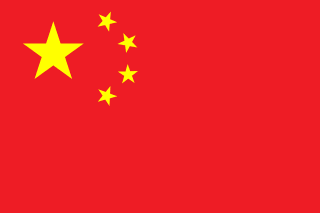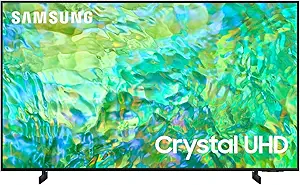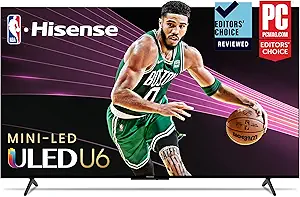Samsung, a South Korean multinational conglomerate, is a leading brand in the television market with a reputation for cutting-edge technology and high-quality products. Their televisions are known for their superior picture quality, innovative features, and sleek designs. Samsung's latest models incorporate advanced technologies such as QLED, which offers brilliant colors and deep contrasts, and AI upscaling, which uses artificial intelligence to enhance the resolution of lower-quality content. However, Samsung televisions tend to be more expensive than many other brands, which may be a deterrent for some consumers. On the other hand, Hisense, a Chinese multinational major appliance and electronics manufacturer, offers televisions that are generally more affordable while still providing good quality and features. Hisense televisions often incorporate technologies such as ULED, which is similar to Samsung's QLED and provides excellent color and contrast. Hisense also offers smart TVs with built-in Roku, providing easy access to streaming services. However, while Hisense televisions are generally well-received, they may not offer the same level of picture quality or advanced features as Samsung's high-end models. Compared to Samsung, Hisense is a relatively newer and less established brand in many markets, which may impact consumer trust and perception.
Key Features Comparison
Picture Quality
Top-Rated Picture Quality Brands
Samsung televisions, particularly their QLED range, are renowned for their exceptional picture quality. They utilize Quantum Dot technology, which allows for a wider color gamut and better brightness, resulting in vibrant and lifelike images. The QLED TVs also have excellent contrast ratios and deep blacks due to their full-array local dimming feature. However, they can be quite expensive compared to other brands, and some users have reported issues with viewing angles, where the picture quality decreases when viewed from the side. On the other hand, Hisense televisions, especially their ULED range, offer impressive picture quality at a more affordable price point. Hisense uses Ultra LED technology, which also provides a wide color gamut and high contrast ratio, although it may not be as bright as Samsung's QLED TVs. Hisense TVs also feature Dolby Vision HDR and HDR10, enhancing the dynamic range of the content, making the bright parts brighter and the dark parts darker. However, Hisense TVs may not have as deep blacks as Samsung's QLED range, and the overall picture quality, while excellent, may not be as refined as that of Samsung.
Design
Samsung and Hisense televisions both offer unique designs that cater to a variety of user preferences. Samsung, a leading brand in the television industry, is known for its sleek, modern designs that often feature slim bezels and clean lines. Their latest models, such as the Samsung Frame and Serif TVs, are designed to blend seamlessly with your home decor, with the Frame model looking like a piece of artwork when not in use. The Serif model, on the other hand, is designed to stand out as a piece of decorative furniture. However, these unique designs often come with a higher price tag compared to other brands. Hisense, while not as globally recognized as Samsung, has been gaining popularity for its affordable yet well-designed televisions. Hisense TVs typically feature a more traditional design, with wider bezels and a more substantial stand. However, their latest ULED range showcases a sleeker design with a thinner bezel, aiming to provide a more immersive viewing experience. One potential downside to Hisense TVs is that their designs, while functional, may not be as aesthetically pleasing or innovative as those offered by Samsung or other high-end brands. However, they offer excellent value for money, making them a popular choice for budget-conscious consumers.
Sound
Top-Rated Sound Quality Brands
Samsung televisions are renowned for their superior sound quality, often incorporating the latest technologies such as Dolby Atmos and Q-Symphony. Dolby Atmos, in particular, provides a three-dimensional sound experience, enhancing the overall viewing experience. Samsung's Q-Symphony technology, available in their QLED models, synchronizes TV speakers and soundbar together for a more immersive sound. However, some users have reported that the sound quality can vary between models, and higher-end models tend to offer better sound quality. On the other hand, Hisense televisions also offer good sound quality, with some models featuring Dolby Atmos technology. However, Hisense primarily uses dbx-tv sound technology in their televisions, which delivers deep, rich, and immersive sound. While the sound quality of Hisense televisions is generally good, it may not match the depth and immersion offered by Samsung televisions, particularly the high-end models. However, Hisense televisions are often more affordable, making them a good option for those on a budget who still want decent sound quality. Compared to other brands, both Samsung and Hisense offer competitive sound quality, but Samsung might have an edge with its advanced sound technologies.
Quality & Performance
Samsung televisions are renowned for their quality and performance, with the brand consistently incorporating the latest technologies into their products. Samsung's QLED technology, for instance, offers a high dynamic range (HDR) for brighter, more vibrant colors, and deeper blacks. The brand's Smart TV interface is also user-friendly and responsive, providing seamless access to a wide range of apps and services. However, Samsung televisions tend to be more expensive than other brands, which may deter budget-conscious consumers. On the other hand, Hisense televisions offer competitive quality and performance at a more affordable price point. Hisense uses ULED technology, which, similar to Samsung's QLED, aims to enhance color, contrast, and brightness. Hisense TVs also come equipped with Dolby Vision HDR and Dolby Atmos for an immersive viewing and listening experience. However, the brand's Smart TV interface is not as intuitive as Samsung's, and the build quality of Hisense TVs is often reported to be less robust. Despite these drawbacks, Hisense televisions provide good value for money, especially for consumers prioritizing cost-effectiveness.
Smart TV & Connectivity
Samsung televisions are renowned for their smart TV capabilities and connectivity options. They come with the latest Tizen OS, which is highly responsive and offers a wide range of apps from their app store. Samsung TVs support both Wi-Fi and Ethernet connections for internet access, and also include Bluetooth connectivity for wireless audio devices. They also feature multiple HDMI and USB ports for connecting various devices. Samsung has also integrated its SmartThings platform into its TVs, allowing them to serve as a hub for smart home devices. However, Samsung TVs are relatively expensive and their smart features may require some learning curve for non-tech savvy users. On the other hand, Hisense televisions also offer smart TV features and connectivity options, but they operate on either Android TV or Roku TV platforms. These platforms offer a vast array of apps and streaming services, making Hisense TVs versatile in terms of content availability. Hisense TVs also support Wi-Fi, Ethernet, and Bluetooth connections, and have multiple HDMI and USB ports. Additionally, Hisense TVs with Android TV can also serve as a smart home hub through Google Home. Hisense TVs are generally more affordable than Samsung TVs, but their picture quality and build may not be as premium. Also, the user interface on Hisense TVs may not be as smooth or intuitive as Samsung's Tizen OS.
Brand Reputation
Samsung is a globally renowned brand in the television industry, with a reputation for delivering high-quality products that incorporate the latest technology. Samsung's QLED technology, for example, is highly praised for its superior picture quality, offering vibrant colors and deep blacks. Samsung televisions are also known for their smart features, with built-in voice assistants, and a user-friendly interface. However, Samsung's high reputation often comes with a higher price tag, which can be a deterrent for some consumers. On the other hand, Hisense, a Chinese brand, has been steadily gaining recognition in the global market. Hisense is known for offering good quality televisions at a more affordable price point, making it a popular choice for budget-conscious consumers. Hisense TVs, particularly their ULED range, provide excellent picture quality and smart features, although they may not be as advanced or refined as those offered by Samsung. However, Hisense's brand reputation is not as established as Samsung's, and some consumers may be hesitant to choose Hisense over more recognized brands. Despite this, Hisense continues to grow its reputation by consistently delivering good quality products and improving its technology.
Brightness
Samsung and Hisense televisions both offer high-quality displays with varying levels of brightness. Samsung, with its latest QLED technology, has an edge in terms of brightness. The Quantum Dot technology in Samsung TVs allows them to achieve a peak brightness of around 2000 nits, which is impressive and provides excellent visibility even in well-lit rooms. Additionally, Samsung TVs are known for their High Dynamic Range (HDR) performance, which enhances the brightness and contrast ratio, providing a more vivid and realistic viewing experience. On the other hand, Hisense televisions, particularly those with ULED technology, also offer good brightness levels but they are generally lower than those of Samsung. The peak brightness of Hisense TVs usually ranges from 1000 to 1500 nits. However, Hisense TVs are praised for their local dimming features, which can enhance the perceived brightness and contrast by dimming areas of the screen that are supposed to be dark while keeping the bright areas illuminated. This can result in a more balanced and comfortable viewing experience, especially in dark rooms. Compared to other brands, both Samsung and Hisense offer superior brightness levels, but Samsung generally has the upper hand in this aspect.
Smart Features
Samsung televisions are renowned for their smart features, which are powered by their proprietary Tizen operating system. The smart features in Samsung televisions include voice control through Bixby, Google Assistant, and Amazon Alexa, access to a wide range of apps through the app store, and the ability to connect and control smart home devices. Additionally, Samsung's latest models come with features like Ambient Mode, which allows the television to blend into the room when not in use, and SmartThings, which enables users to control and monitor their smart home devices directly from their television. However, Samsung televisions are generally more expensive than other brands, and some users have reported that the Tizen operating system can be slow and unresponsive at times. On the other hand, Hisense televisions use either the Roku TV or Android TV platforms for their smart features, depending on the model. These platforms provide access to a vast range of apps and streaming services, and they also support voice control through Google Assistant and Amazon Alexa. Hisense's VIDAA U platform, available on some models, offers a simplified, customizable interface that makes it easy to navigate the television's smart features. Hisense televisions are generally more affordable than Samsung models, but they often lack some of the more advanced smart features found in Samsung televisions, such as Ambient Mode and SmartThings. Additionally, while the Roku TV and Android TV platforms are well-regarded for their ease of use and wide range of apps, they do not offer the same level of integration with other devices as Samsung's Tizen system.
Remote Control
Samsung televisions come with a sleek and modern remote control known as the Samsung One Remote. This remote has a minimalist design with fewer buttons, which makes it easier to use. It is also equipped with voice control functionality, allowing users to change channels, adjust the volume, and control other features using voice commands. The one Remote can also be used to control other devices connected to the television, such as gaming consoles and Blu-ray players, which eliminates the need for multiple remotes. However, some users may find the lack of traditional buttons and reliance on voice control a bit challenging to get used to. On the other hand, Hisense televisions come with a more traditional remote control. It has a larger number of buttons, which may appeal to users who prefer a more tactile experience. Hisense remotes also have dedicated buttons for popular streaming services like Netflix and YouTube, providing quick and easy access to these platforms. However, Hisense remotes lack the voice control feature found in Samsung's One Remote, which may be a disadvantage for some users. Additionally, while Hisense remotes can control some connected devices, they may not be as universally compatible as Samsung's One Remote.
Conclusion
When it comes to the latest technology and features, Samsung televisions are often at the forefront. Samsung's QLED technology, for example, offers exceptional picture quality with vibrant colors and deep blacks. The brand also incorporates smart features like Bixby voice assistant, SmartThings home automation, and an intuitive Tizen operating system. However, Samsung TVs are typically more expensive than other brands, which might be a con for budget-conscious consumers. On the other hand, Hisense televisions offer good value for money. They may not have the same cutting-edge technology as Samsung, but they still offer decent picture quality and smart features. Hisense uses VIDAA U as its operating system, which is user-friendly and straightforward, although not as advanced as Samsung's Tizen. One significant advantage of Hisense TVs is their affordability, making them a popular choice for those on a budget. However, the picture quality, particularly in terms of color accuracy and contrast, may not be as impressive as that of Samsung TVs.


















